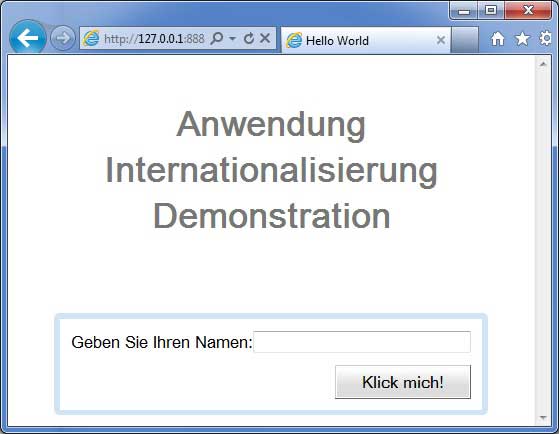
- GWT 教程
- GWT - 首頁
- GWT - 概述
- GWT - 環境搭建
- GWT - 應用
- GWT - 建立應用
- GWT - 部署應用
- GWT - 使用 CSS 樣式
- GWT - 基本部件
- GWT - 表單部件
- GWT - 複雜部件
- GWT - 佈局面板
- GWT - 事件處理
- GWT - 自定義部件
- GWT - UIBinder
- GWT - RPC 通訊
- GWT - JUnit 整合
- GWT - 除錯應用
- GWT - 國際化
- GWT - History 類
- GWT - 書籤支援
- GWT - 日誌框架
- GWT 有用資源
- GWT - 問答
- GWT - 快速指南
- GWT - 有用資源
- GWT - 討論
GWT - 國際化
GWT 提供三種國際化 GWT 應用的方法,我們將演示靜態字串國際化,這是專案中最常用的方法。
| 序號 | 技術與描述 |
|---|---|
| 1 |
靜態字串國際化 此技術最為普遍,執行時開銷極小;對於翻譯常量字串和引數化字串都非常高效;實現最簡單。 靜態字串國際化使用標準 Java 屬性檔案來儲存翻譯後的字串和引數化訊息,並建立強型別 Java 介面來檢索其值。 |
| 2 |
動態字串國際化 此技術非常靈活,但比靜態字串國際化慢。宿主頁面包含本地化字串,因此當我們新增新的語言環境時,不需要重新編譯應用程式。如果 GWT 應用程式要與現有的伺服器端本地化系統整合,則應使用此技術。 |
| 3 |
可本地化介面 此技術是三種技術中最強大的。實現 Localizable 允許我們建立自定義型別的本地化版本。這是一種高階國際化技術。 |
GWT 應用國際化的工作流程
步驟 1 - 建立屬性檔案
建立包含應用程式中要使用的訊息的屬性檔案。在我們的示例中,我們建立了一個 **HelloWorldMessages.properties** 檔案。
enterName = Enter your name
clickMe = Click Me
applicationTitle = Application Internationalization Demonstration
greeting = Hello {0}
建立包含特定於語言環境的翻譯值的屬性檔案。在我們的示例中,我們建立了一個 **HelloWorldMessages_de.properties** 檔案。此檔案包含德語翻譯。_de 指定德語語言環境,我們將在應用程式中支援德語。
如果使用 Eclipse 建立屬性檔案,則將檔案的編碼更改為 UTF-8。選擇檔案,然後右鍵單擊以開啟其屬性視窗。選擇文字檔案編碼為 **其他 UTF-8**。應用並儲存更改。
enterName = Geben Sie Ihren Namen
clickMe = Klick mich
applicationTitle = Anwendung Internationalisierung Demonstration
greeting = Hallo {0}
步驟 2 - 將 i18n 模組新增到模組描述符 XML 檔案
更新模組檔案 **HelloWorld.gwt.xml** 以包含對德語語言環境的支援
<?xml version = "1.0" encoding = "UTF-8"?> <module rename-to = 'helloworld'> ... <extend-property name = "locale" values="de" /> ... </module>
步驟 3 - 建立與屬性檔案等效的介面
透過擴充套件 GWT 的 Messages 介面來建立 HelloWorldMessages.java 介面,以包含對國際化的支援。它應該包含與屬性檔案中的鍵相同的函式名。佔位符將被字串引數替換。
public interface HelloWorldMessages extends Messages {
@DefaultMessage("Enter your name")
String enterName();
@DefaultMessage("Click Me")
String clickMe();
@DefaultMessage("Application Internalization Demonstration")
String applicationTitle();
@DefaultMessage("Hello {0}")
String greeting(String name);
}
步驟 4 - 在 UI 元件中使用訊息介面。
在 **HelloWorld** 中使用 **HelloWorldMessages** 物件獲取訊息。
public class HelloWorld implements EntryPoint {
/* create an object of HelloWorldMessages interface
using GWT.create() method */
private HelloWorldMessages messages =
GWT.create(HelloWorldMessages.class);
public void onModuleLoad() {
...
Label titleLabel = new Label(messages.applicationTitle());
//Add title to the application
RootPanel.get("gwtAppTitle").add(titleLabel);
...
}
}
國際化 -完整示例
此示例將引導您完成簡單的步驟,以演示 GWT 應用程式的國際化功能。
按照以下步驟更新我們在《GWT - 建立應用》章節中建立的 GWT 應用程式:
| 步驟 | 描述 |
|---|---|
| 1 | 建立一個名為 *HelloWorld* 的專案,放在 *com.tutorialspoint* 包下,如《GWT - 建立應用》章節中所述。 |
| 2 | 修改 *HelloWorld.gwt.xml*、*HelloWorld.css*、*HelloWorld.html* 和 *HelloWorld.java*,如下所述。保持其餘檔案不變。 |
| 3 | 編譯並執行應用程式以驗證已實現邏輯的結果。 |
以下是修改後的模組描述符 **src/com.tutorialspoint/HelloWorld.gwt.xml** 的內容。
<?xml version = "1.0" encoding = "UTF-8"?> <module rename-to = 'helloworld'> <!-- Inherit the core Web Toolkit stuff. --> <inherits name = 'com.google.gwt.user.User'/> <!-- Inherit the default GWT style sheet. --> <inherits name = 'com.google.gwt.user.theme.clean.Clean'/> <!-- Specify the app entry point class. --> <entry-point class = 'com.tutorialspoint.client.HelloWorld'/> <extend-property name = "locale" values="de" /> <!-- Specify the paths for translatable code --> <source path = 'client'/> <source path = 'shared'/> </module>
以下是修改後的樣式表文件 **war/HelloWorld.css** 的內容。
body {
text-align: center;
font-family: verdana, sans-serif;
}
h1 {
font-size: 2em;
font-weight: bold;
color: #777777;
margin: 40px 0px 70px;
text-align: center;
}
以下是修改後的 HTML 宿主檔案 **war/HelloWorld.html** 的內容。
<html>
<head>
<title>Hello World</title>
<link rel = "stylesheet" href = "HelloWorld.css"/>
<script language = "javascript" src = "helloworld/helloworld.nocache.js">
</script>
</head>
<body>
<h1 id = "gwtAppTitle"></h1>
<div id = "gwtContainer"></div>
</body>
</html>
現在在 **src/com.tutorialspoint/client** 包中建立 HelloWorldMessages.properties 檔案,並將以下內容放入其中
enterName = Enter your name
clickMe = Click Me
applicationTitle = Application Internationalization Demonstration
greeting = Hello {0}
現在在 **src/com.tutorialspoint/client** 包中建立 HelloWorldMessages_de.properties 檔案,並將以下內容放入其中
enterName = Geben Sie Ihren Namen
clickMe = Klick mich
applicationTitle = Anwendung Internationalisierung Demonstration
greeting = Hallo {0}
現在在 **src/com.tutorialspoint/client** 包中建立 HelloWorldMessages.java 類,並將以下內容放入其中
package com.tutorialspoint.client;
import com.google.gwt.i18n.client.Messages;
public interface HelloWorldMessages extends Messages {
@DefaultMessage("Enter your name")
String enterName();
@DefaultMessage("Click Me")
String clickMe();
@DefaultMessage("Application Internationalization Demonstration")
String applicationTitle();
@DefaultMessage("Hello {0}")
String greeting(String name);
}
讓我們使用以下 **src/com.tutorialspoint/HelloWorld.java** Java 檔案的內容,我們將用它來演示 GWT 程式碼的國際化功能。
package com.tutorialspoint.client;
import com.google.gwt.core.client.EntryPoint;
import com.google.gwt.core.client.GWT;
import com.google.gwt.event.dom.client.ClickEvent;
import com.google.gwt.event.dom.client.ClickHandler;
import com.google.gwt.event.dom.client.KeyCodes;
import com.google.gwt.event.dom.client.KeyUpEvent;
import com.google.gwt.event.dom.client.KeyUpHandler;
import com.google.gwt.user.client.Window;
import com.google.gwt.user.client.ui.Button;
import com.google.gwt.user.client.ui.DecoratorPanel;
import com.google.gwt.user.client.ui.HasHorizontalAlignment;
import com.google.gwt.user.client.ui.HorizontalPanel;
import com.google.gwt.user.client.ui.Label;
import com.google.gwt.user.client.ui.RootPanel;
import com.google.gwt.user.client.ui.TextBox;
import com.google.gwt.user.client.ui.VerticalPanel;
public class HelloWorld implements EntryPoint {
/* create an object of HelloWorldMessages interface
using GWT.create() method */
private HelloWorldMessages messages =
GWT.create(HelloWorldMessages.class);
public void onModuleLoad() {
/*create UI */
final TextBox txtName = new TextBox();
txtName.setWidth("200");
txtName.addKeyUpHandler(new KeyUpHandler() {
@Override
public void onKeyUp(KeyUpEvent event) {
if(event.getNativeKeyCode() == KeyCodes.KEY_ENTER){
Window.alert(getGreeting(txtName.getValue()));
}
}
});
Label lblName = new Label(messages.enterName() + ": ");
Button buttonMessage = new Button(messages.clickMe() + "!");
buttonMessage.addClickHandler(new ClickHandler() {
@Override
public void onClick(ClickEvent event) {
Window.alert(getGreeting(txtName.getValue()));
}
});
HorizontalPanel hPanel = new HorizontalPanel();
hPanel.add(lblName);
hPanel.add(txtName);
VerticalPanel vPanel = new VerticalPanel();
vPanel.setSpacing(10);
vPanel.add(hPanel);
vPanel.add(buttonMessage);
vPanel.setCellHorizontalAlignment(buttonMessage,
HasHorizontalAlignment.ALIGN_RIGHT);
DecoratorPanel panel = new DecoratorPanel();
panel.add(vPanel);
Label titleLabel = new Label(messages.applicationTitle());
//Add title to the application
RootPanel.get("gwtAppTitle").add(titleLabel);
// Add widgets to the root panel.
RootPanel.get("gwtContainer").add(panel);
}
public String getGreeting(String name){
return messages.greeting(name + "!");
}
}
準備好所有更改後,讓我們像在《GWT - 建立應用》章節中那樣,在開發模式下編譯並執行應用程式。如果應用程式一切正常,則會產生以下結果:

現在更新 URL 以包含 locale=de。設定 URL: *http://127.0.0.1:8888/HelloWorld.html?gwt.codesvr=127.0.0.1:9997&locale=de*。如果應用程式一切正常,則會產生以下結果:
